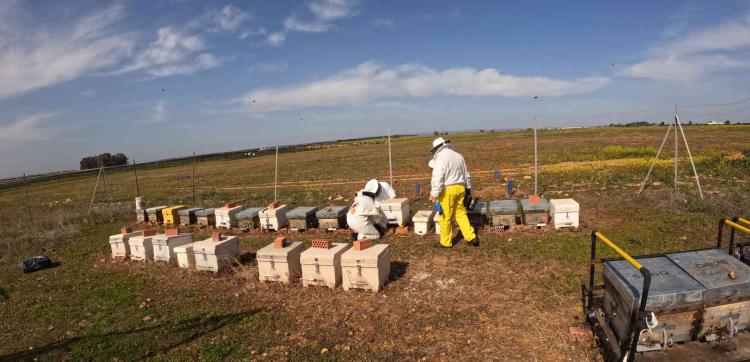Highlights
- Endesa has two solar plants in Carmona, Las Corchas and Los Naranjos, which have become a benchmark in Spain as a result of the development of initiatives including the first solar apiary, agrivoltaic cultivation and grazing as a natural means of clearing the land.
- Now the company's renewable subsidiary, Enel Green Power España (EGPE), is going further and restoring the land with new plant species that help to improve the habitat by creating a small nature reserve or ecological corridor that acts as a protected shelter.
The solar plant of Endesa's renewable subsidiary, Enel Green Power España (EGPE), in Carmona is becoming an environmental benchmark by including pioneering initiatives since its launch in 2019, such as the first solar apiary, agrivoltaic cultivation or grazing.
Now, Endesa has gone a step further and is recovering 9 hectares of land within the perimeter of this facility, where there are no panels since this area was formerly used as a "dump". The goal of this initiative is to achieve a vegetation cover based on the natural and indigenous seed pool, to improve the structure and composition of the land and to add greater biodiversity (flora and fauna) in terms of plant species of different sizes and functions.
To recover this land, Endesa's renewable subsidiary, EGPE, has used plants and the most innovative technology: hydroseeding. Using specialised machinery, a mixture of water and different components such as herbaceous seeds, grasses, legumes and shrubs, fertilisers, pH correctors, mulch and special additives are placed in the selected land, so that the soil may be restored 25% faster than using any other planting alternative.
Hydroseeding is carried out in two passes: first the mixture of seeds, fertiliser, additives and water; and then only elements (mulch and stabilisers) that help to improve the fixation of the mixture in the field.
"With this type of initiative, we show that we are going one step further in caring for the environment. Not only do we ensure the strict environmental compliance of our plants, but we also seek specific solutions and opportunities adapted to each site that allow us to enhance, promote and conserve the biodiversity of our facilities and their surroundings," said Juan Abad, Endesa's head of environment for solar plants. "This initiative in the Las Corchas solar plant is a clear example since we harness disused, somewhat damaged land to create a natural habitat of high value, free of the influence of the agro-industrial environment, and that will become a shelter for fauna, flora, and in this case an added value for the new solar apiary."
After the hydroseeding is complete, a team of environmental technicians will be reforesting this area with some tree specimens (stone pines, wild olive trees, mastic trees or kermes oaks), shrub plants (palm hearts, myrtles or blackberry) and finally, in greater proportion and distribution, native aromatic plants such as rosemary, lavender or thyme-marjoram. The purpose is not only to have a plant space that helps the dissemination of local birds, but also to offer the bees of Carmona's solar apiary more sustenance to carry out their work.

Worker planting seedlings at the Las Corchas solar plant after preparing the land with hydroseeding.
Since this solar apiary was launched in March 2021, 80,000 bees from 35 hives installed in Endesa's photovoltaic plant have produced 500 kilos of honey free of pesticides and full of green energy.
The 2.8 million bees owned by Juan Ignacio and his son, fourth and fifth generation of Loramiel, are also participating in an environmental study by the association El Rincón de la Abeja. Its chair, Paola Vecino, has recently travelled to Carmona to install new sensors in the hives to digitalise them and apply environmental monitoring measures to identify the proliferation of animal species in the solar plant's environment.
"The spaces occupied by photovoltaic plants can be an ideal place for the promotion of biodiversity in these areas," explains Paola Vecino, chair of Rincón de la Abeja, "since they are controlled areas and allow the free transit of numerous species in the absence of phytosanitary products or other substances commonly used in rural areas."
Endesa, through its renewable subsidiary EGPE, is developing with this association a study of the bee population. For this, 3Bee monitoring systems have already been installed to determine the number of specimens in the solar apiary, biophonies are being registered in the areas around the apiary, and a study of the floral load in the area and a map of ecological interaction will be created. "All to study and publicise the positive impact of this coexistence," says Vecino.

Innovation installation in the beehives of the Las Corchas solar plant in Carmona.
About Endesa
Endesa is the largest electricity company in Spain and the second largest in Portugal. The company is also the second largest gas operator in the Spanish market. Endesa operates an end-to-end generation, distribution and marketing business. Through Endesa X it also offers value-added services aimed at the electrification of energy use in homes, companies, industries and Public Administrations. It has also created a new business line, Endesa X Way, which is fully dedicated to electric mobility, as well as being firmly committed to the United Nations SDGs, and strongly supports the development of renewable energies using all technologies (ultrafast, fast and semi-fast) through Enel Green Power España, the digitalisation of grids through e-distribución, and corporate social responsibility (CSR). The Endesa Foundation is also active in CSR-related matters. We have about 9,260 employees. Endesa is part of Enel, the largest electricity group in Europe.









